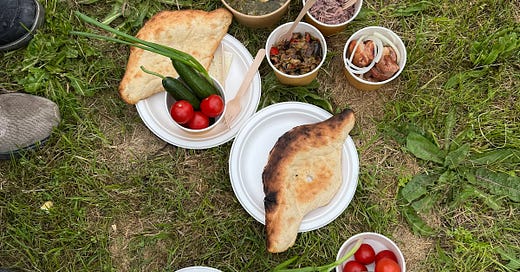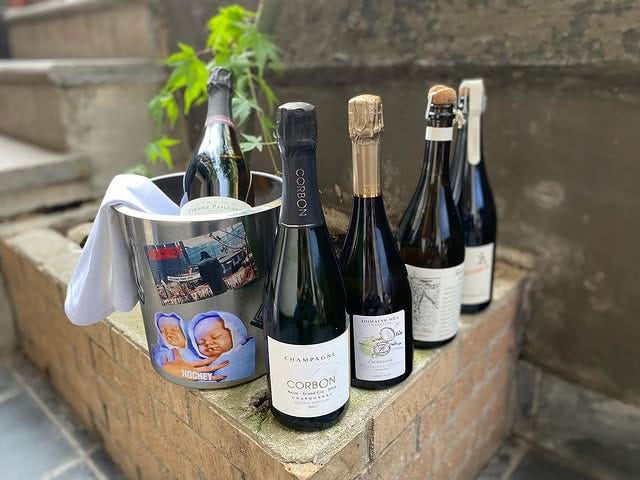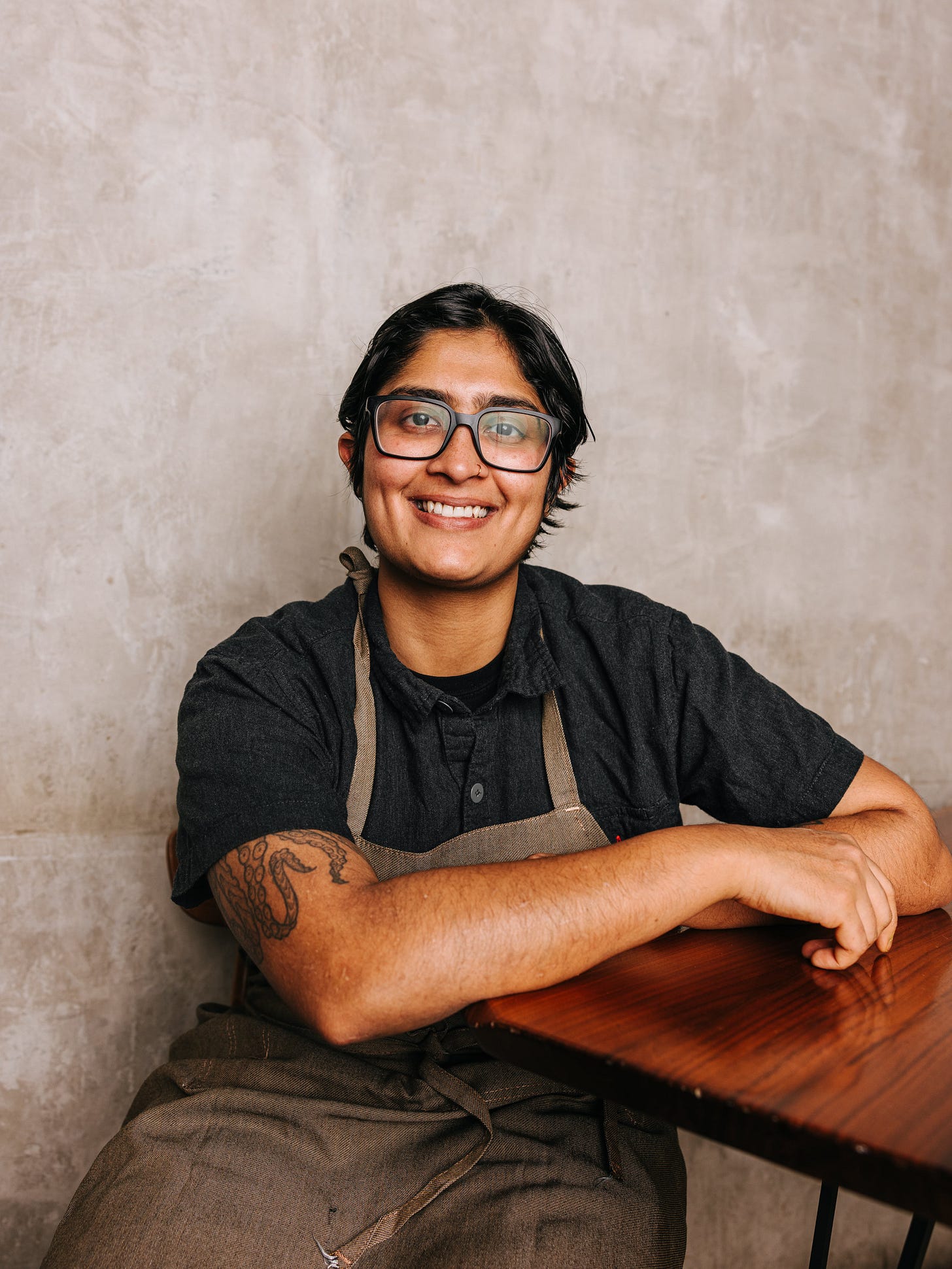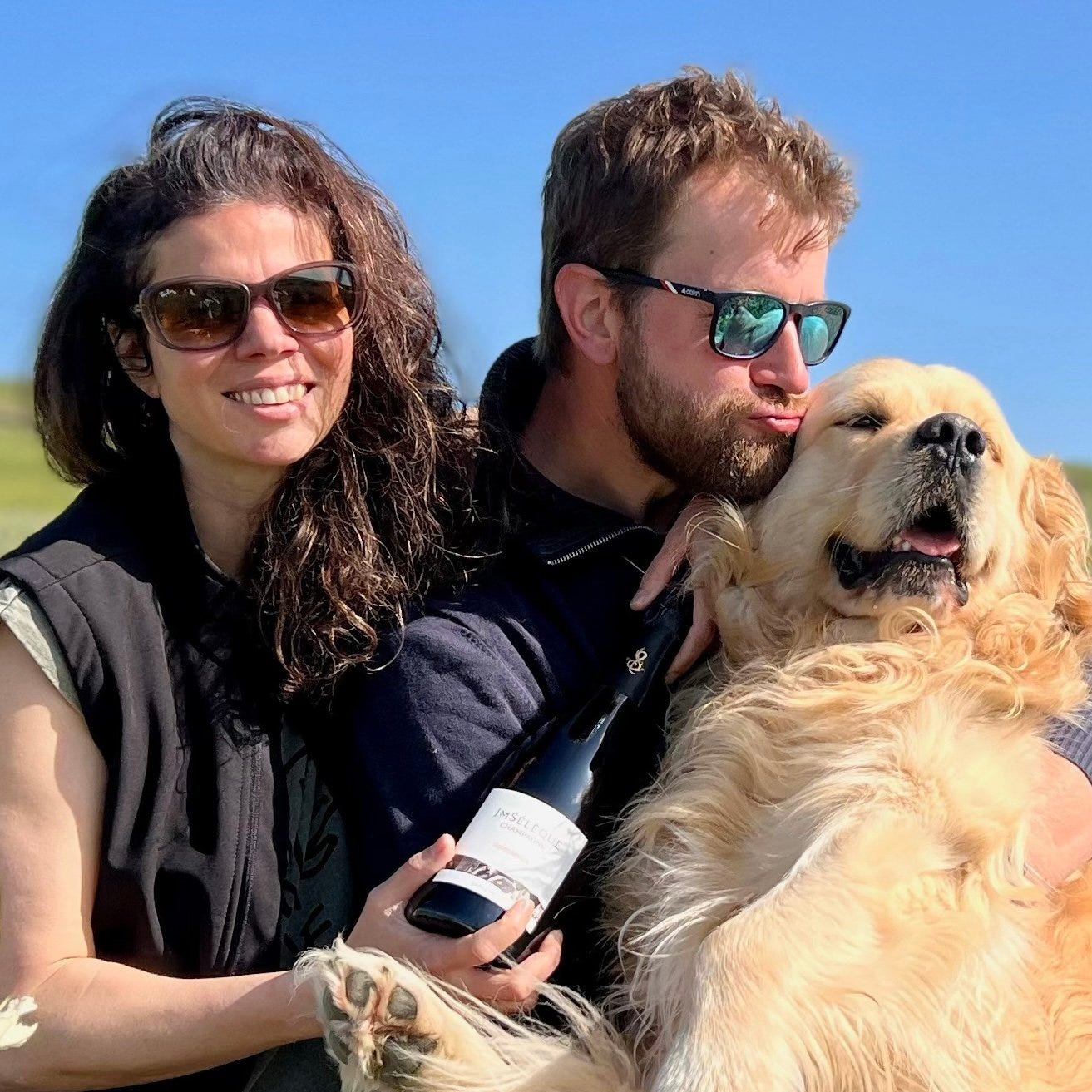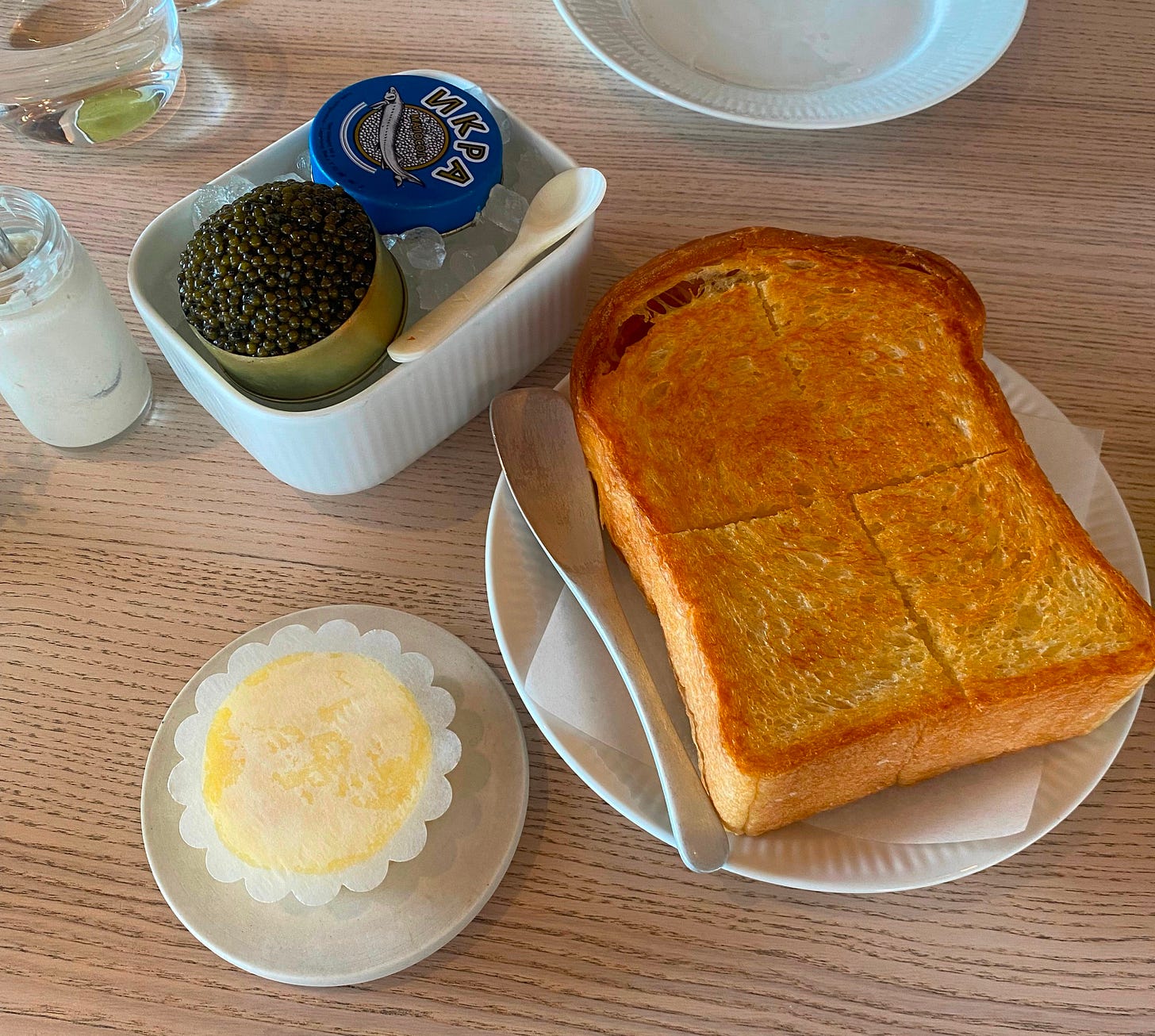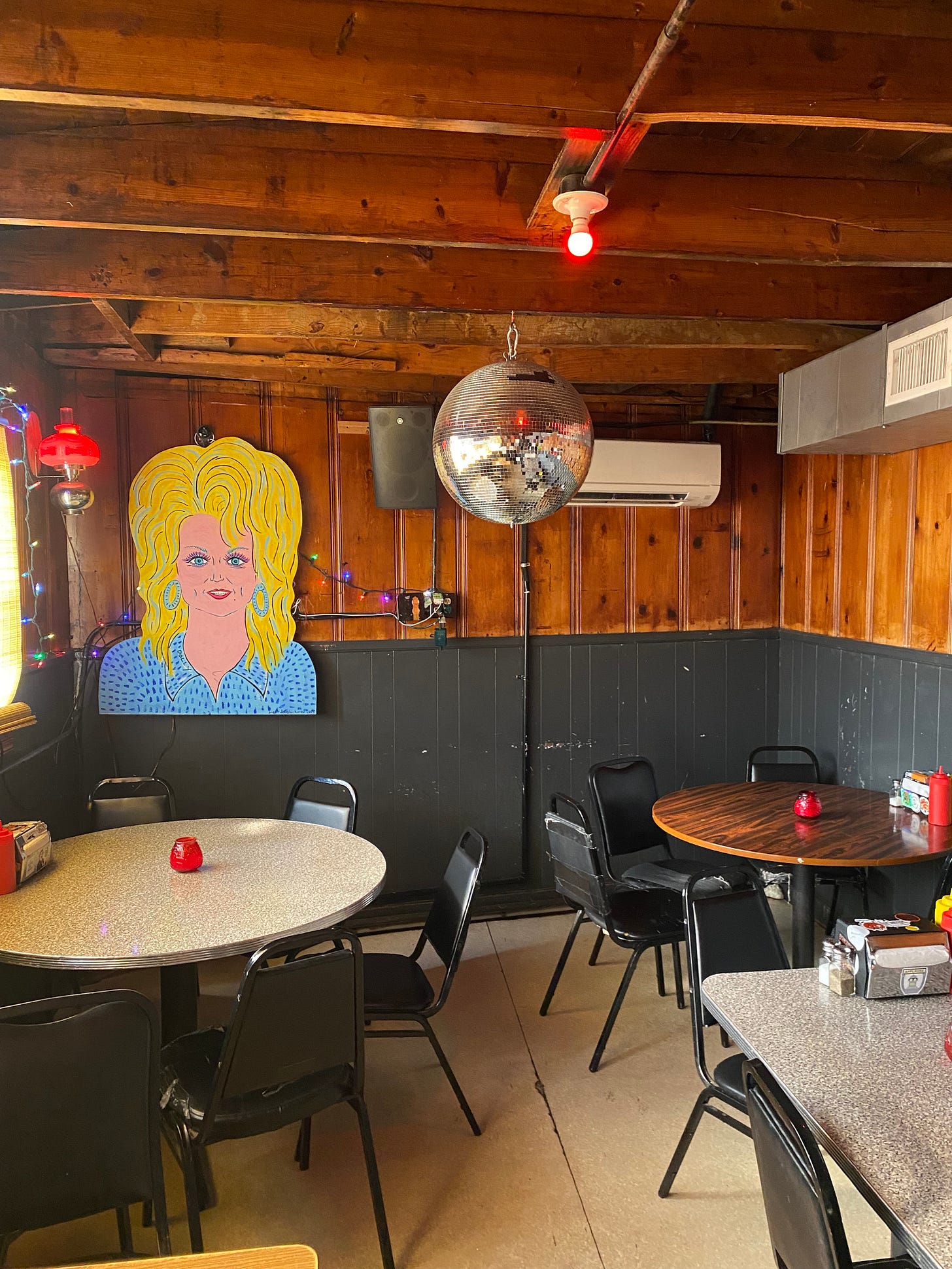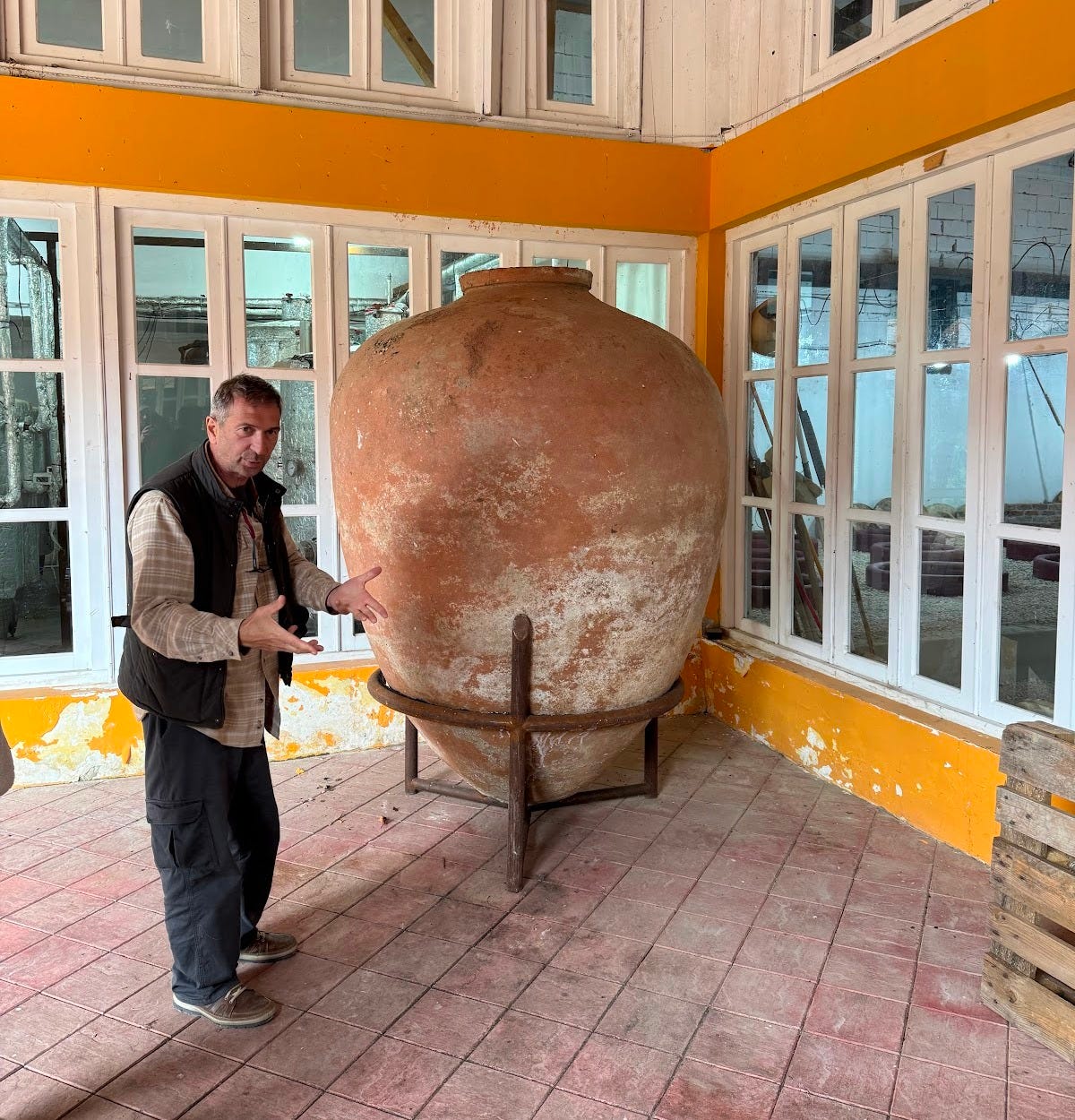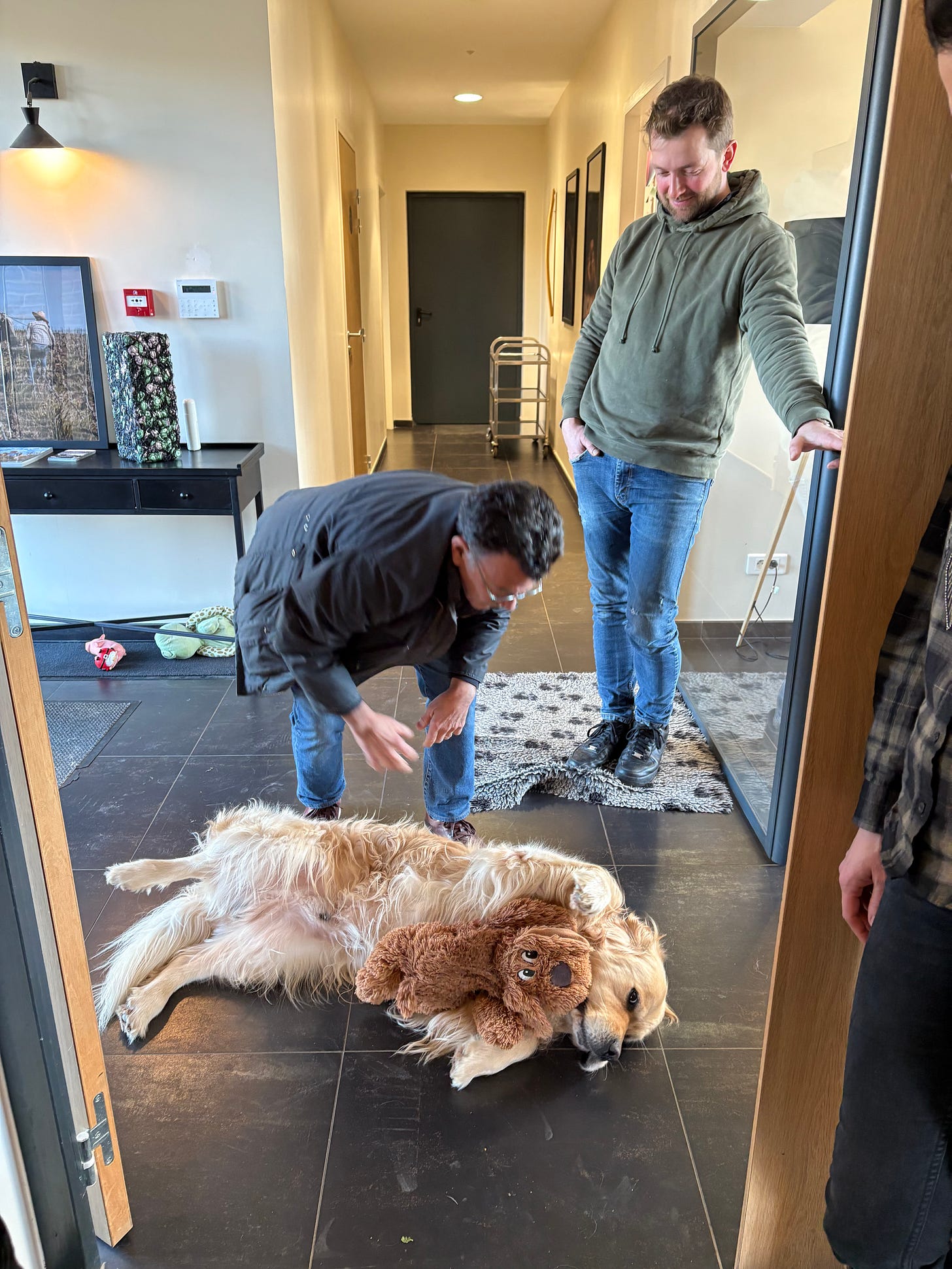In honor of the feverish wanderlust that tends to set in this time of year, we’re taking things on the road to far-flung places: reporting back from wine-soaked days spent among 8,000-year-old vines, chance encounters on the BNA airport tarmac, and tête-à-têtes with a dog named Charmant.
We travel first to Champagne (not once, but deux fois), double back to Nashville for the Smithereens pop-up at Iggy’s (and late-night snacks to remember), and then wander back across the great big sea to Georgia, where the wine is deep and textured, living proof of an ancient and formidable viticulture.
The theme for this issue took shape as we debuted a new edition of the wine program at Smithereens—moving on from grenache to Champagne. And while there’s obvious appeal to a glass of bubbly on a humid day, beverage director Nikita Malhotra convinces us there’s more to it than hits the tongue. For No Spitting, she brings us dispatches from two recent trips to the region, highlighting a few producers changing the game—and one in particular that caught her off guard, awash in sudden joy, eager to bring all of this effervescence home with her (jovial vineyard pup not included, sadly).
From there, we travel onward, but first up: don’t miss our guest chef dinner with Mythily on Tuesday, July 1st!
We hope you’ll get your own chance to wander far afield this summer—but most of all, we hope you come back home to our beloved city to join us for a bottle of Champagne, try the new beans (!) or pine nut tart, and tell us all about your trip.
Till then,
Smithereens
p.s. speaking of our beloved city, don’t forget to vote!
Mythily x Smithereens
For the latest installment of the Smithereens Book Club (aka our guest chef series), we’ve got Chef Rasika Venkatesa’s Mythily popping up for one night only, on Tuesday, July 1st. Reservations are live, you know what to do!
After moving to the US from Chennai, India in 2019, Chef Rasika Venkatesa developed her career in the Bay Area across several fine dining kitchens, including The French Laundry, Alexander’s Steakhouse, and Rich Table, rising to CDC at Mourad at the age of 23. Awarded the Rising Chefs Award in 2022 by Star Chefs, Rasika also competed on season 21 of Bravo's Top Chef and took over at Fulgurances, Laundromat for their Winter ‘24 residency (hot off the heels of our own Nicholas Tamburo).
Then came her own pop-up concept Mythily, dedicated to her grandmother Mythily Ramachandran and the state of Tamil Nadu. Integrating finely honed techniques with an emphasis on seasonality and traditional flavors, Mythily is Chef Rasika’s progressive take on South Indian cuisine.
Chef Rasika Venkatesa will cook alongside us in the kitchen, offering up à la carte dishes like scallops with neer mor and plum; swordfish with mango, swiss chard, and porichu kazhumbu; and paruppu poli with white chocolate, cherries, and hazelnuts to top things off.
Q&A: Chef Rasika Venkatesa answers the Smithereens Questionnaire
What is one thing you will always order if you see it on a menu?
I think the one thing I always order is … chicken wings! In any form—be it fried or roasted or grilled, tossed in any kind of sauce, I can really go to town on a big bowl of wings.
Where in the world would you most like to travel to at this moment?
Japan has been very high on my list. I've never visited and have only heard amazing things about the lifestyle, food, and mindset. I would love to go and spend a couple of months living there.
It is your last meal on Earth, what are you having for dinner?
Anything cooked by my grandmother honestly! I especially love her lunch combination of kathirikkai curry (slow roasted spiced eggplant), mor kuzhambu (warm butter milk gravy), beans paruppu usili (green beans with fluffed lentils) and rice. Leaving the earth after this meal would be a great way to go.
What is an ingredient that you can't live without?
Obviously every spice in the world! Literally though. But in all seriousness—an ingredient I can't live without would probably be coconut. I feel like coconut in all its stages and forms is super versatile and does as much as you want to in a dish, or as little. It also has so many health benefits and works just as well as dairy in any dish.
Traveling through Tamil Nadu
On the hunt for Akkaravadisal
In a move very on-brand for this issue, in 2024 Chef Rasika left her stable job in San Francisco to travel for a month and a half along the state of Tamil Nadu to find out more about Tamil cuisine and where she came from. You can read about that trip here.
No Spitting
A whirlwind tour through Champagne
Nikita Malhotra, Beverage Director/Partner
This year I spent a collective two weeks in Champagne, first in the frigid month of January, when the region still felt deep in slumber and you could hear the crunch of ice as you walked through the vineyards, and another visit this past March, the vineyards teaming with the promise of spring—sun soaked, scenic, and warm. I had a chance to visit about 20 producers, in a dizzying race to understand the complexities of the region and transport some of those lessons back with me. Smithereens has seen two themes in terms of the wine list: riesling and grenache; themes that I am quite attached to and have fostered a relationship with throughout my career. So, the next region or style we picked had to resonate in a similar way; there had to be a story that felt genuine for us to tell in our space.
And on that later trip, while tasting in a vineyard in Ludes, a premier cru site in the Montagne de Reims, the new theme became clear to me; I immediately wanted to transport all the joy I felt in that moment back to the list at Smithereens.
Even before my journeys this year I’ve loved Champagne, which doesn’t seem unique exactly—every wine professional has some kind of relationship with Champagne. We all drink Champagne more than anything else for its ease and luxury; we can drink Champagne with any course at dinner and pair it with fast food or, just as readily, a tasting menu. I’ll drink it to celebrate, to mourn, or to mark the everyday. I once designed a beverage pairing with just sparkling wine, and so 80% of that pairing was Champagne—no one complained! But there are so many ambassadors for this region and for these wines in restaurants and wine shops across the world that it begs the question: why bother concentrating on something that is already beloved?
Yet, with every visit to Champagne I have come to realize that for every question asked there comes an answer, and yet more questions. Just understanding the basics of Champagne—secondary fermentation, resting on the lees, cork vs. cap in terms of aging, different presses, disgorgement, etc.—can take years, and everyone has different perspectives, as expected, but all those different voices make Champagne a very complicated wine.
One day I might be in the mood for a Champagne from Avize, a Blanc de Blancs that is clearly etched and has dimension to it, a balance of high acidity and concentration. Another day I might crave a more vinous and ripe Pinot Noir-based Champagne from Bouzy. To focus on just Champagne with this iteration of the list is to explore the diversity of this region, offering up the chance to bring the stories of the vineyards and the winemakers I visited back with me.
Here’s an attempt to do just that, and a sneak peek at some of the producers you’ll find on the list these days:
DOMAINE MÉA
This was the producer that brought me to Ludes on a warm spring day and made me feel at harmony with the world, if only for a second or two, but certainly long enough to make me want to bottle this up for everyone back home. Five generations of the Méa family have made wine in the Grand Cru Village of Louvois. Starting with Gilbert Méa in 1922, family knowledge has been passed down, first from father to son, then father to daughter, and now from mother to daughter. The tiny Grand Cru of Louvois is named after the wolves (‘loup’ in French) that used to emerge from the forests above and wander down through the vineyards and out to hunt. This is why you might spot a playful illustration of a wolf on some of the Méa labels. Sophie represents the fifth generation, and with her husband Franck, who’s originally from Bordeaux, they’re a Champagne producer worth seeking out. Having seen multiple parcels of theirs and how they treat each vineyard with attention and care, and with a very terroir-minded outlook, Domaine Méa represents a new chapter for the region.
Look for these on the list:
Champagne Cuvée Prestige "Le Grillon" Extra Brut 1er Cru
L’assemblage Extra Brut
Louvois Blanc 2022
Bouzy Rouge 2022
CORBON
I remember the first time I tasted Corbon; it was a 1987 Blanc de Blancs that I ordered on a random night at Terroir in Tribeca. I wasn’t expecting much, but the age intrigued me. Tasting the wine was revelatory; it had dimension and clarity, it was transparent about its age, but also fresh and precise in a way that highlighted its birthplace of Avize. Agnès is at helm now, and visiting her was quite special. The history of Champagne Corbon dates back to the 1920s, when Agnès’ great-grandfather, Charles Corbon, moved to Avize and acquired his first vines. His son, Albert, had little interest in viticulture, so the company fell quiet for much of the 1900s. It wasn’t until the 1970s, when Agnès’ father Claude took the helm, that Champagne Corbon transformed into a producer of its own right. In 1972, fed up with buyers asking if they could pay for grapes a year late, Claude realized that he could “just bottle it and sell it himself by June,” in Agnès’ words. Agnès is warm, witty, and fun, and it is quite hard to peel yourself away from her and her winery. She is terrified of flying; the memory of a short flight on a small plane with her daughter instilled such a strong fear in her that she only travels via trains and boats. So, let’s all get together and get her a boat trip over here someday soon!
Look for these on the list:
Blanc de Blancs 2002
Blanc de Blancs 2013
Blanc de Blancs 2014
A. LAMBLOT
The visit to Alexandre Lamblot in January was the very last visit on that trip’s itinerary. But it was magical—exhaustion and fatigue lifted as he talked through the project and we saw some of his vineyards. Here is the next generation, a continuation of the grower champagne producers we saw over a decade ago. His importers and wine collectors point out similarities to Jérôme Prévost, as their vines in Gueux are next to one another and both focus on Pinot Meunier. Although this comparison is fitting, it would be tragic if Alex’s wines were to become as difficult to source as Prévost’s are now, but he does deserve the praise. Alex is serious and thoughtful, a couple of nights prior to this visit he was smiling quietly while I debated Jean-Marc Sélèque on Cristal, probably amused that I was sipping on a bottle of Pignan 2010 while defending my love of this tête de cuvée. Alex’s vision and ambition are exciting: he cares about diversity and health in his vineyards—we saw a chicken coop and small trees in the vineyard—and his ambition of vinifying all his plots separately, and his focus on long aging, are things that perk my interest. There are many in the Champagne world who are patiently waiting to see what the future holds here but already, the wines shine and excel.
Look for these on the list:
La Coroche Brut Nature NV
Les Fourgons Brut Nature NV
Mouvance Brut Nature NV
Intuition Brut Nature NV
J-M Sélèque
Anytime a dog comes running up to greet you at a winery, it’s going to be a good time, especially if that dog is named Charmant. Jean-Marc is really making a case for the Marne Valley, he loves to showcase the distinct terroirs. Chardonnay on sand and Meunier on chalk are tasted in the cellar, and in my case tasted blind, with canisters of the different soils present, bearing witness to how some decisions cannot be based on theory, but instead should be appreciated through experience and practice. There is little to no dosage, and there is a purity here that is hard to put into words, just drink the wine! A bit of history: in 1925, Henri, Jean-Marc's grandfather, arrived from his native Poland and settled in Boursault in the Marne valley on the southern slopes of Epernay. He planted vines in the 1960s in Moussy and Pierry, marketing his first bottles in 1969. His son, Richard, an oenologist by training, modernized winemaking and streamlined the domaine. Then in 2008, Richard’s son, Jean-Marc, returned to the domaine, fresh off some New World experiences in Napa Valley and Australia, equipped with his own ideas of how to move things forward. Since his arrival, Jean-Marc and his wife Oriane have converted most of the vineyards to bio-dynamic farming and begun aging the wines in Burgundy barrels.
Look for these on the list:
Coteaux Champenois Dizy Blanc 2021
Soliste Chardonnay Les Tartieres 2019
Dispatch from Music City
Nicholas Tamburo, Chef/Owner
A couple weeks ago, the Smithereens team flew down to Nashville to cook with our friend Ryan Poli at his restaurant, Iggy's. I first met Ryan when I was a sous chef at Momofuku Ko and he was about to start his gig as the chef at The Catbird Seat. These days he's serving some really delicious and innovative pastas; we loved the tortelloni filled with duck confit and dressed with a bunch of beautiful spring vegetables. They also have a pretty killer cellar list.
After service, Ryan and Matthew (his brother and partner in Iggy's, who runs the beverage program) took the whole team out to Bad Idea for a late night snack. I'm now telling everyone I know that they need to eat here when they go to Nashville. Colby Rasavong is the chef/owner there and he is cooking extremely delicious things. The menu is sort of equal parts French and Laotian. We loved his bologna sandwich which incorporates a lot of Lao flavors alongside a potato chip aioli. He also serves the best approximation of McDonald's french fries I've ever had. The space is beautiful and the wine list is super unique and thoughtful.
Of course we had to visit our friends at Locust for lunch. The only way to eat at Locust is to order the entire menu, so go and do that. I truly believe that Locust is one of the best restaurants in the world. Their potato bread with caramelized scallop butter and caviar is one of the best things I've ever eaten.
We also popped into Turkey and the Wolf Ice House, Dino's, Kisser, and Santa's Pub. Of course no trip to Nashville would be complete without a visit to Robert's Western World.
A few words of advice: you must go to Dino's. The vibes are immaculate and one should never try to perform Scatman at karaoke.
Before we left, I sat down with Ryan to record an episode of his podcast How Did I Get Here?
On the plane back to NYC I was reading I Regret Almost Everything, Keith McNally's excellent new memoir. Turns out, Keith was also on my flight, he was in Nashville working on his new location of Pastis. I ended up sitting next to Keith's assistant (fascinating in her own right, she used to be a professional chess player and represented the Philippines in the Chess Olympiad) and she offered to introduce me when we got off the plane.
Then this happened.
Keith, if you're reading this, come to Smithereens! We love you.
Georgia, The Whole Day Through
Jacob Dorman, Server
It’s my fifth day in Georgia and I just need a fucking beer, or as it turns out a cider. We (being me and eleven other wine degenerates from the states and Canada) have been zigzagging across this beautiful country from Tbilisi to Kakheti to Kutaisi and back, and all we have been drinking is wine that is straight tannin. I’m desperate for some residual sugar. I’m worried I’m about to begin growing vines inside me à la Chucky in Rugrats.
Today we are back in Tbilisi for a big wine festival, Zero Compromise, and after an hour so of walking around quaffing Rkatsiteli and Saperavi and Chacha (their national liquor, made from the stems and skins of grapes, anywhere from 40-50% ABV), this angelic Georgian man blesses my glass with a cider made from local apples. It’s one of those moments where your body was begging you for something and you didn’t realize it, until you serendipitously come upon just the thing it requires. It’s so good I have to walk out of the abandoned factory where the winemakers are pouring and sit at one of the many folding tables set up to the left of the factory.
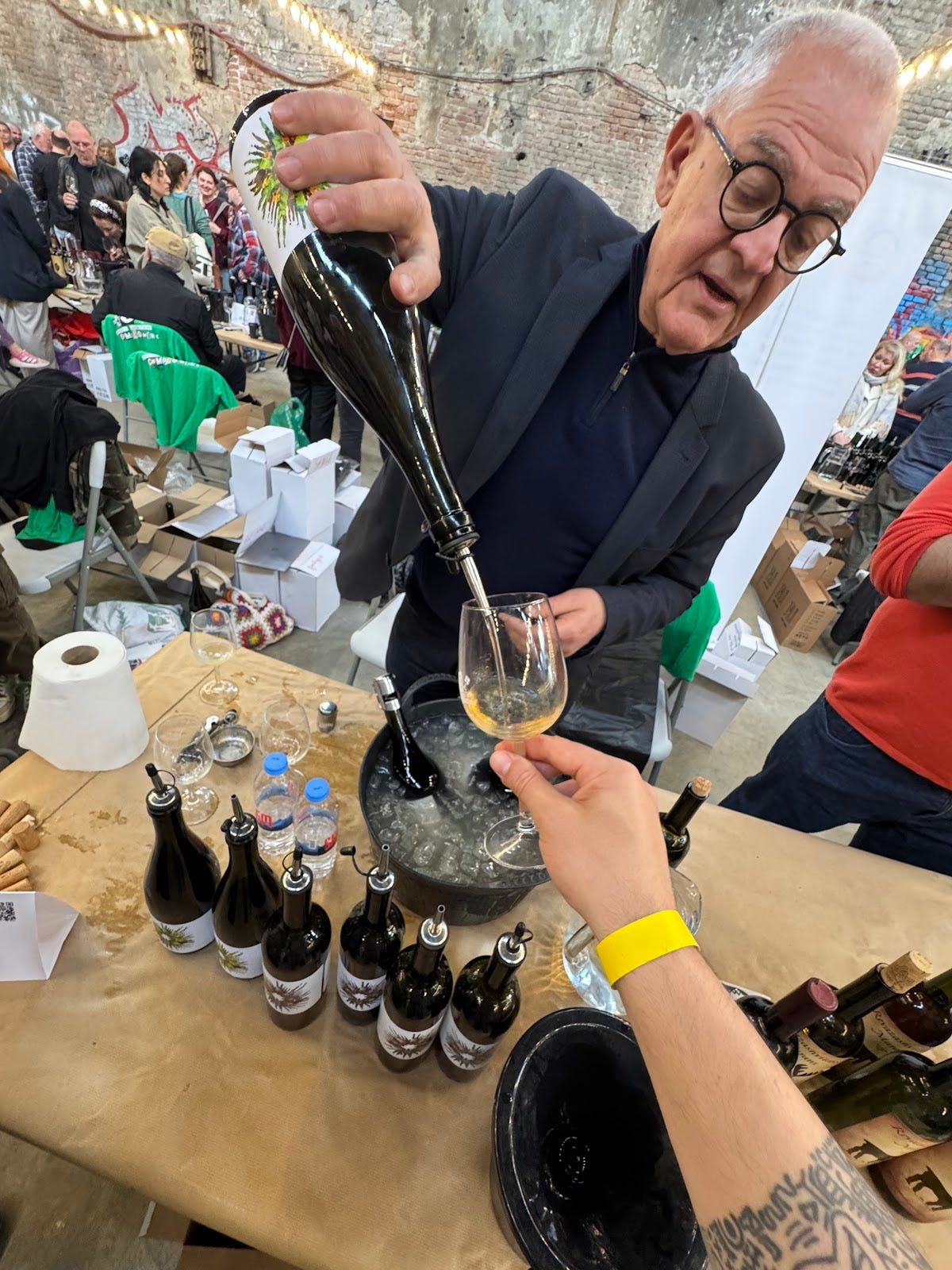
This may all sound like I’m denigrating Georgian wine in favor of this cider, but I am not—I truly love their wine. Georgians will tell you that their country was the first to make wine, and while this is debatable, what’s not is that the country does have an 8,000-year-long tradition of beautiful winemaking. Georgia is also the birthplace of amber wine, more commonly and recently called orange wine. The amber wines here are indeed that color; the experience of drinking them feels close to what I imagine drinking liquid amber to be like.
The aforementioned Rkatsiteli and Saperavi are the most popular white and red varietals, respectively, but Georgia is home to 400 grapes. What’s more important to the story of Georgian wine is not so much the grapes themselves, but the Qvevri, the vessels in which they are aged. Other countries use large clay pots like this to age wine but the Qvevri are unique for their shape and composition, as well as being the first vessels of their kind. There are five master Qvevri makers and only they know the exact composition of these pots.
The combination of these grapes and vessels, as well as the terroir and winemaking traditions of Georgia, have produced unique and idiosyncratic wines that truly do not taste like the wines of any other country. They are dense and inscrutable. They need your attention. The ambers are not chewy or grippy but almost sticky in texture and bracingly dry. They taste of walnuts and dates and really good rye bread. The reds are beyond inky, vampiric, you can hold them up to the sun and it barely shines through. Both the reds and ambers (they make fantastic sparkling and rosé too, one of my favorite wines from this trip was a pét-nat made with honey) demand to be eaten with food, ideally the cuisine we were often fed there: lamb roasted on metal spears over fire, bread baked on the side of the same ovens like tandoori, stewed eggplant, fresh tomatoes and cucumbers from neighboring Azerbaijan, Sulguni (a local cheese and the saltiest thing I have ever eaten), khinkali (soup dumplings), and khachapuri (bread stuffed with cheese made in various forms, most famously the cheese boat).
Working at and frequenting the various natty wine haunts of New York circa 2017, I remember seeing wines from places like Georgia, Slovenia, Slovakia, or The Czech Republic amongst others, popping up on lists. While I loved a lot of these wines, I also thought this was some hipster bullshit. Wine directors with hand tattoos were desperately trying to make their lists the most esoteric or singular or whatever. They are still perceived by many to be too niche and hipster-y to be taken seriously. This is of course a great disservice to the winemaking traditions of these countries—they deserve to be taken just as seriously as France or Italy, if not more so.
This reduces Georgia, her people, and her wines to a trend, which also isn’t fair. Georgia is a place. Her people and wine are real. You can go there and see the beauty of the Caucasus. You can talk to the people and drink their wine with them. And when you drink that wine, you will be engaging with the long history of the country. It’s a cliché, but wine tells a story, and this a story that Americans haven’t yet heard in full. We are worse off for that.
Wine represents about 70% of Georgian exports, so in many ways it is, admittedly, the easiest avenue to engage with this country. Drinking Georgian wine can also represent a political choice. Russia poses a serious threat to her; the Kremlin already occupies a small part of Georgia. On Google Maps (!) you can even see a divot in the border of the country due north of Tskhinvali; that is Russian-occupied Georgia. Georgians are increasingly wary of becoming the next Ukraine. The best way for them to protect themselves against this is economic freedom (Georgia is seeking EU membership, you see a lot of EU flags around the country) and maybe the best way we, as outsiders, can support that is by drinking Georgian wine.
Let’s return to my glass of cider. Those first five days had been a whirlwind. Georgians do indeed love to drink and are quite insistent that you partake as well; I felt like I had been drunk or hungover for most of those 125 hours. I just wanted to sit down for a minute, and here I am at this plastic folding table with my cider and my thoughts. The cider glistens and shimmers in the glass. A demure 3% ABV, it goes down almost too easily. It tastes like the apple-iest apple I’ve ever had. I understand how this can keep the doctor away. The first few days in Georgia were littered with rain storms but the sun has finally joined us on the trip today, shining, it appears, just for me and this moment of apple-tinged relief. I take another sip and look around me and I see Georgians. I see them drinking their wine, the fruits of their labor, and sharing it with Americans, Canadians, Australians, Danes, and more.
For all this talk of wine as an experience or a journey or a political act, in the end it is also simply this: a glass, an encounter, a moment in a place. Today, that place just happens to be Georgia. Drink deep, my friends.
Before You Go . . .
Chef Joshua Pinsky (Claud, Penny) gives Smithereens—and the celery float—a hearty shout out in a New York Times piece on where chefs love to dine out right now.
We all scream for ice cream, especially Bon Appetit.
Thrilled to see The Infatuation ranked our “shamelessly saucy” lobster roll #1 in the city!
One more pic of Charmant before you go:

